




Your education guide to understanding the show


Did you know that The Public first opened in September 1975? We are entering our 51st season this year! We have not always been at this location The Public Theater spent 24 years on the North Side (in what is now the New Hazlett Theater) before moving to its current home the O’Reilly Theater in the heart of downtown Pittsburgh’s Cultural District. The new performance space, which was built by the Pittsburgh Cultural Trust, opened with the world premiere of August Wilson’sKing Hedley IIin December 1999
The ground on which we currently stand, at the confluence of the Allegheny, Monongahela, and Ohio Rivers, is home to the Seneca People More information about our land acknowledgement and why it’s important to honor those who came before us can be found here: PPT.org/Mission
The mission of Pittsburgh Public Theater is to provide artistically diverse theatrical experiences of the highest quality We also strive to challenge and entertain our audiences through unique and captivating storytelling We look forward to continuing to expand and diversify our audience and enrich our Pittsburgh community and beyond. Visit our website to learn more: PPT.org
Our theater is a thrust stage, which means the audience sits on three sides of the stage This creates a really fun and inclusive environment to experience our shows In fact, because of this design, there isn’t a bad seat in the house!
So, whether it’s your first time joining us, or you have visited many times, thank you for being here. We hope you have a wonderful experience!
Attending a student matinee at Pittsburgh Public Theater is an exciting event Everyone in the audience has been looking forward to seeing the performance just as much as you have, so it’s very important to remember the rules of theater etiquette Live theater, or theater seen in person, is much different from going to the movies or streaming a show at home The one big difference is that the actors are performing for you live onstage, and they can see and hear what goes on in the audience just as you can see and hear them. Because of that, the way people behave at a play is different from when they’re at the movies or at home Here are some things to keep in mind to guarantee that everyone has a fun, safe, and enjoyable time
Please be on time Do your best to arrive on time and with enough wiggle room to use the restroom before the show starts
Stay with your group and wait to be seated - we want to make sure everyone is in the right place. All cellphones and electronics must be turned off or silenced before the show starts. We will usually make an announcement before the show as a reminder
The light and motion of your devices can be distracting to the audience and performers so refrain from texting as well If your phone rings during the performance, turn it off and don’t answer Allow yourself to fully experience the performance without any distractions.
Be polite, attentive, and respectful. Our Student Matinee audience includes teachers and students from all areas of the city and disciplines of study. Remember, your behavior affects the experience for the entire audience as well as the actors
Be mindful of side conversations: don’t talk during the performance, as this can disturb the audience and performers

However, don’t be afraid to react appropriately to the performance:laugh when something is funny, cry when it’s sad, or gasp if it’s shocking This is what makes live theater so much fun!
Use the restroom before the show, after the show, or at intermission If you get out of your seat during the performance, it is distracting to the students around you If you need to use the restroom during the performance, please do your best to wait and exit during a break, such as between musical pieces or scene changes.
Please keep entrance aisles clear for the performers and crew
Don’t chew gum, drink beverages, or eat during the performance
Stay for the curtain call! Not everyone stays to watch movie credits roll, but in theater, applauding for the actors is a way you can show them how much you enjoyed their performance.
Review theater etiquette with your students and chaperones and set definite guidelines before attending any performance
Make sure that your chaperone to student ratio makes it possible for you to enforce your instructions and that your chaperones know what is expected of them Let your students know that improper behavior will not be tolerated and follow through If the show is performed with an intermission, it will generally be just long enough for the audience to use the facilities and stretch their legs.
We do not serve concessions during student matinees.
This show is a “huge cross departmental collaboration....Visually, it seems like the actors are getting the applause at the end of the show, but I wish people would have it in their thoughts that they're clapping for everybody who worked on the show”
Howdidyougetintotheater?
MysisterdidtheaterfirstandIthoughtshewasthe coolest,soofcourse,IwantedtodoitThefirstbigshow IdidwasWestSideStorywhenmymomwasthe choreographeratthehighschool.Iwasinseventhgrade, buttheyhadnobrownpeople,sosheaskedifIwould wanttodoitThatwasabigleapformebecauseIwas painfullyshyWhenIgottohighschoolitdidn'tmake senseformetodotheaterbecauseIwassoshy,but thoseweretheonlyfriendsIhad,so,Ijustkeptdoingit andtheneventually,IstoppedbeingshyTheaterwas thefirstthinginmylifeIfeltpassionateaboutIwas goodatalotofthings.Iwasverysmartandgoodat academics,buttheaterwasthefirstthingIfeltpassion forandIfeltthatwasimportant,soIkeptgoingwithit
Saymoreaboutpassion-whataboutitfeltdifferentto youthanotherthingsyouweregoodat?
IthinkitwastheonlyplaceintheworldthatIfoundthat thethingsthatwerestrangeaboutmeweremygreatest assetsandactuallymademeveryskilled.Thoseskills didn'tseemtofitanywhereelseintheworld,especially sociallyButforsomereason,theyfitreallywellinthe theaterandletmebegoodatit
Sofromthere,howdowegettofightchoreography?
IwasamartialartistbeforeIdidanyactingtrainingIdid noactingclassesoranythinguntilIwenttoNYUfor undergradThereIsawpeoplewalkingaroundwith swords,soIfollowedthemanddiscoveredthatstage combatwasitsowndiscipline.WhenIfoundoutthatthe twothingsIwasmostpassionateaboutintheworldmartialartsandtheater–couldcometogether,Ifound theperfectlittlecornerthatworkedformeI'vebeen choreographinglittletoyfigurinefightsforaslongasI canremember.Obsessedwithfightsonfilm,would watchthemoverandover,andneverthoughtitwould amounttoanythingSo,onceIstartedstagecombatand fightchoreography,itwasjustthere,likeoh,thisisthe thingI'vealreadybeendoing,soIjustkeptdoingitand neverstopped
Tellmemoreaboutthedifferentkindsoftrainingyou havedone.
Itisn'tabsolutelynecessarytobeamartialartisttobea goodfightdirectororfightchoreographer.Ofcourse,It isincrediblyhelpfulI’venoticedthatalotofthereally knowledgeableanddynamicfightdirectorsalso

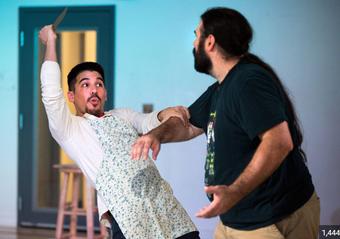

happen to either be current martial artists or have some training in it But stage combat training is essential Some people will come from adjacent fields, like getting experience in renaissance fairs, or historical martial arts, or will come from the stunt world for film While a lot of those have overlapping ideas and training, stage combat for live theater is very specific.
I trained with the Society of American Fight Directors. They’re nationally and internationally recognized, and have a rigorous set of standards you need to meet There’s a lot of training and testing involved to get certified in different weapon sets or, as a fight director and certified teacher I do think you should also be looking for secondary training like martial arts, and do a lot of reading.
Whatarethedifferencesbetweenstuntandfight choreographythatweseeinfilmandtelevisionvs. theater?
They'reverydifferentbeasts.Thereisalotofoverlap intermsoftechniqueandsafety,butwithfilm,you onlyhavetodoitperfectlyonceIntheater,youhave todoitperfectlyeverysingletimeInfilm,there'sonly onepointofview,whichisthecamera,whichallows youtodoamillionthingsyoucouldn'tdointheater Bothofthosefactsmakeitacompletelydifferent game.
Intheater,youhavepointsofviewfromalloverthe theater.Especiallyifyou'reintheroundorinadeep thrustlikewehaveLet'ssaywe'replayingapunchto theface Ofcourse,we'renotactuallypunching somebodyintheface,sothatmeansthatthereisairor distancebetweenthefistandtheperson'sface.Forthe magicofstagecombattowork,wehavetouseyour depthperceptionagainstyousoyoudon'tseethegap betweenthefistandtheface.Butifthereisaudience tothesidesofme,likeinathrust,suddenlyIhavea problemThenIhavetostartgettingcleverIhaveto getreallyprecisewithmyangles-workingalotof diagonalsandtryingtoputinmoremotiontodistract you

Infilm,youhavesomuchmorecontrolthanyoudoin theaterYoucanalsodosomereallyheavyimpactand dangerousstuntsbecause,ifyouhavewelltrained people,you'reonlygoingtodoitmaybethreetimes andneveragainWhereintheater,we'reabouttodo somestuntsinNoisesOffthatarequitedangerous,soI havetotackleaverydangerousstuntbutalsobe awarethatIamgivingsomethingtoanactorthat they'regoingtohavetodoa100timesfull-outSoI havetodesignsomethingthatstilllooksreallyscary anddangerous,butissafeenoughthatIalsoknowthey candoitthroughouttherunoftheshowwithout gettinghurt
Anotheraspectofyourworkisintimacychoreography. Howdoesitcomparetofightwork? Thereisalotofoverlapbetweenbeingafightdirector andanintimacydirectorThereisabigfocusonsafety, coaching,andcollaboratingwithactors.Youfocuson choreographythattellsthestory,issustainable,andis safe,andisrepeatableSoalotofthoseconceptsare thesame.
There'sspecificintimacytraining,andtherearealsoa lotofspecializationswithinitbecauseitcanbesuch sensitivework.It’snotevenalwaysaboutphysical
touch, intimacy can include moments that are sensitive and loaded. We carry our cultures and our lived experiences with us in our bodies. One could say the politics of our bodies are present Intimacy is a lot more personal The actors are portraying characters, but it's still them, in their bodies, on the stage I think it's even more important for an intimacy director to be really keyed into people's body language, and being really clear and thorough with communication Facilitation skills are really important to me, it’s a very valuable discipline - How do I talk to people? How do I talk to different people? When's the right time? How much is too much? That's something that can be tough as an intimacy director; it depends on the show, but sometimes your role can feel very small because that's what that team needs Too much can sometimes make things worse You want to find the right amount of support to empower them
What is your favorite type of fighting style or resource that you might not get to use often?
I'd say two things Scrappy, found weapons Having a lot of objects available that we can safely hit the actors with, that won't break and won't hurt the actors, and that the props department won't kill me over It's so much fun and is always thrilling to audiences And you can just get really creative. I recently did a show where we had a lot of that. You know, we had books, we had pans, we had spatulas. Then in terms of proper weaponry, I like what I would call a basic knight sword where you can handle it single handed. It still has a bit of length on the blade, and has a cross guard so when you block a weapon, you can still use the cross guard to capture the opponent's blade a little bit But, again, is light enough that you have a free hand that then we can get into some unarmed and grappling and controlling the other person That allows for, I think, a lot of cool dynamics, and a lot of options
To be successful, you will need to
Understand stage combat techniques, which combine both safety and storytelling.
Design moments that are theatrically compelling and serve the story
Communicate clearly with actors and designers
Tellusmoreaboutworkingasateam
AlotofitisaboutpuzzlesolvingEveryshowisa differentpuzzlebecauseofhowtheaudienceisseated, wheretheactorsenduponstage,what'saroundthem, whatthepropsarelike,andwhatthecostumesarelike Youhavetoworkwithalloftheselittlepiecesand makeitallwork.Andthen,alotofpeopleknow,that thosethingscanchangereallyrapidly,andsuddenly onethingthatwasagreatassettoyoumightbetaken offthetableforonereasonoranotherSoyoualso havetobeagoodcollaborator
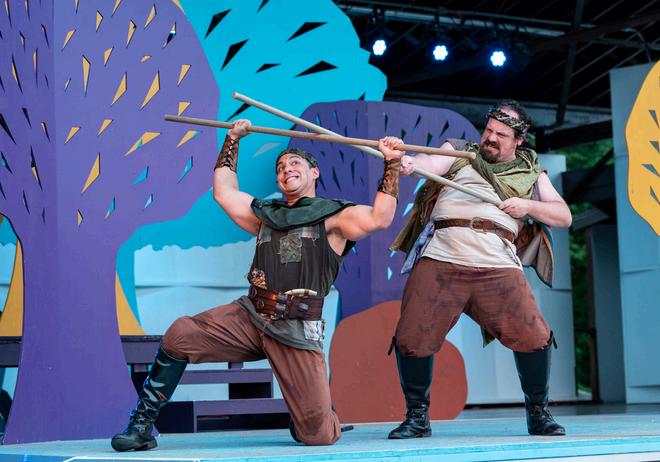

Flexibility is key You can have so many plans in place, especially for your choreography, but it has to work with the actors too We're all different physical individuals, so something I might choreograph for my body might not work for somebody else. Or certain techniques might not make sense to them. So I have to have enough of a breadth of knowledge that I can have a number of options And that's why training is really important to give yourself more than just one option
Whatshouldwebekeepinganeyeoutfor?

Whataudiencesdon’tinitiallysee,butcaniftheyare lookingforit,areallthecomponentsofhugecross departmentalcollaboration We'reonlyabletoachieve bigmomentsbecauseearlyonwe'retalkingwithscenic, withthecarpentersandbuilders-What'stheangleof thisgonnabe?Couldthissetpiecebealittlewider? GettingthatinformationearlyonisimportantsoIcan choreographandgettherightequipmenttotheactor onthefirstday.
Costumesarealsoabigpieceofanysortoflivestunts. Paddingincostumescanhelpreducetheamountof frictionorimpactontheactor And,ofcourse,working withthedirectingandthestagemanagementteamand makingsurewehavetimeandspacesowecanpractice thesetechniques Sofromeverylevel,inamomentthat mightonlylasttwoseconds,allofthesedepartments arehelpingusout We’reallfocusedoncreatingagood, excitingshow,butmostimportantly,asafeshow
Regarded as the ultimate theatrical farce, Noises Off is a riotous rollercoaster of slamming doors, romantic entanglements, and slapstick chaos. Behind the scenes of a disastrous play-within-a-play, a troupe of hapless thespians struggle to bring their production to life. As their rehearsals descend into comedic catastrophe, the actors, director, and stage manager learn the hilarious and hard way what happens when everything that can go wrong does As the actors tour the show, tensions rise, relationships unravel, and the backstage drama becomes even more outrageous than the performance itself This uproarious journey celebrates the absurdity of live theater while celebrating its unpredictability, and will leave you laughing until the final curtain
Act I
The living room of the Brents’ country home. Grand Theatre, Weston-super-Mare Monday, January 14th
Act II
The living room of the Brents’ country home Theatre Royal, Asthon-under-Lyne Wednesday matinee, February 13
Act III
The living room of the Brents’ country home. Municipal Theatre, Stockton-on-Tees Saturday, April 6
ThisproductionofNoisesOffisratedPG-13and containsmaterialthatmaynotbesuitableforall studentaudiences Itincludestheuseofexplicit language,suggestivedialogueandinnuendo,comedic situationsinvolvingromanticmisunderstandings, referencestoalcohol,andinstancesofpartial(nonexplicit)undressinahumorouscontext
Whilethecontentispresentedinafarcicaland exaggeratedtheatricalstyle,werecommendthat educatorspreviewthematerialifpossibleand considerwhetheritalignswiththeirstudents’maturity levels Asyouprepareyourstudentstoseetheshow, pleasetakeamomenttoreviewlivetheateretiquette withthem-Respectfulbehaviorhelpsensureasafe andcomfortableenvironmentforboththeperformers andtheaudience
Theproductionisbestsuitedforhighschool audiencesandcontains:
Language:Mildtomoderateadultlanguage;some innuendoandsuggestivedialogue.
SexualContent:Somecomedicsexualsituations andmisunderstandings;charactersareseen partiallyclothedinhumorous,non-explicit contexts.
Violence:Slapstickphysicalcomedy(ie,falls, slaps,pratfalls)withnoseriousharm.
SubstanceUse:Briefreferencestoalcohol
Themes:Relationships,jealousy,chaosinthe creativeprocess,behind-the-scenesoftheater.
Shouldyouoryourorganizationneedanyadditional informationregardingthecontentofthisshow,please contactSeniorManagerofEducationat jmalarkey@ppt.org
Find the cast and other info about the production in the digital program.

DottyOtley:50s–early60sAveteranactresswhose careeriswaningShehasinvestedintheproductionas awaytosecureherfutureOftendistracted,forgetful, andconfusedbystagedirectionsandprops,especially aplateofsardinesSheisromanticallyinvolvedwith GarryLejeune,creatingtensionbackstage
LloydDallas:40s–50sTheexasperateddirectorof NothingOn,strugglingtoholdtogetheradisintegrating productionwhilemanaginghistangledromantic relationshipswithBrookeandPoppySharpwitanda shortfuse
GarryLejeune:30s–40sAhot-headedandsomewhat dimactorpronetospeakinginhalf-finishedsentences Hehasanon-again,off-againrelationshipwithDotty, whichcontributestotheplay’soff-stagedrama
BrookeAshton:20s.Ayoung,inexperiencedactress primarilycastforherlooks.Oftenoblivioustothe chaosaroundherandmechanicallyfocusedon deliveringherlines,evenwhenthescenehasfallen apart.Shefrequentlyloseshercontactlenses,adding toherconfusion
PoppyNorton-Taylor:20s–early30s.Theoverworked andemotionallyfragilestagemanager,responsiblefor wranglingthecastandhandlingbackstagechaosShe isromanticallyinvolvedwithLloyd,addingtensionto herrole.
FrederickFellowes:30s–40sAwell-meaningbut slow-wittedactorpronetoaskingendlessquestions abouthischaracter’smotivation.Hesuffersfrom frequentnosebleedsatthesightofviolenceorstress
BelindaBlair:30s–40s.Acheerful,competentactress whoactsasthepeacekeeperwithinthecompanyShe isthemostlevel-headedofthecast,withgreat organizationalskills,butalsoenjoysabitofgossip.
TimAllgood:20s–early30sTheperpetually exhaustedassistantstagemanagerandtechnicalcrew memberwhoperformsvariousotherrolesinthe productionHeisresponsibleforlast-minuterepairs, cueinglightsandsound,andevensteppinginfor absentactors.Overworked,andsleep-deprived.
SelsdonMowbray:60s–70sAnelderly,alcoholic actorwithalongbutinconsistentcareerHeoften missescuesandlines,causinghavocduring performancesAffablebutunreliable,withapenchant forstorytellingandsneakingdrinks
Mrs.Clackett:HousekeeperfortheBrents’ countryhome;practical,working-class,with anonchalantattitudetowardthefarcical eventshappeningaroundher.
LloydDallas:Stilltheexasperateddirector ofNothingOn.
RogerTramplemain:Realestateagent tryingtosellthehouse.Romanticlead, suave,charming,butcaughtinincreasingly absurdsituations.
Vicki:Aflirtatioustaxinspector,andoneof Roger’sclients,sheoftengetscaughtinthe middleofRoger’sfarcicalescapades.
PoppyNorton-Taylor:Stilltheveryoverworkedandoverwhelmedstagemanager.
PhilipBrent/Sheikh:Theownerofthe house,hidingfromtaxauthorities.Also appearsasadisguisedArabSheikh.
FlaviaBrent:Philip’swife;refined,upperclassladyofthehouse,poisedand melodramaticinresponsetotheunfolding chaos.
TimAllgood:Stilltheoverworkedand exhaustedassistantstagemanager,tech crew,understudy,etc.
Burglar:Asneakyburglar.Thecharacter’s portrayalisheavilyinfluencedbythe actor’spersonaltraits-namelyhisageand struggleswithalcohol-addingalayerof unpredictabilitytotherole.
1970:BritishPlaywright,MichaelFrayn,getsthe ideatowriteaplayfromthebackstageperspective whilebackstageduringaperformanceofhisplay TheTwoofUs.
1977:FraynwritesaoneacttitledExits,forthe CombinedTheatricalCharitiesattheTheatre Royal,DruryLane.
1977-1982:MichaelCodroncommissionsafulllengthversionoftheone-actandhe,inthewords oftheplaywright,“waitsforitwithintermittent patience”.
1982:WorldPremiereofNoisesOffattheLyric HammersmithTheatreinLondon.Theshowisahit andimmediatelytransferstoSavoyTheaterin London’sWestEnd.
1983:BroadwaydebutattheBrooksAtkinson TheatreinNewYork.
1984:Nominatedfor4Tonyawards,includingbest playandbestdirector.
1992:AfilmadaptationisreleasedbyPeter BogdanovichfeaturingMichaelCaine,Carol Burnett,JohnRitter,andChristopherReeve.
2000:NoisesOffrevivalattheNationalTheatrein Londonsparksnewinterestintheplay.
2001:TheshowseesamajorBroadwayRevivalat theBrooksAtkinsonTheatrestarringPattiLuPone andPeterGallagher.
2015:RoundaboutTheaterCompanyproduces anotherBroadwayrevival,withMeganHilty,and introducestheplaytoanewgenerationoftheatergoers.
2025:NoisesOffopensatPittsburghPublic Theater,directedbyMargotBordelon.
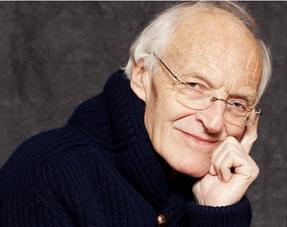

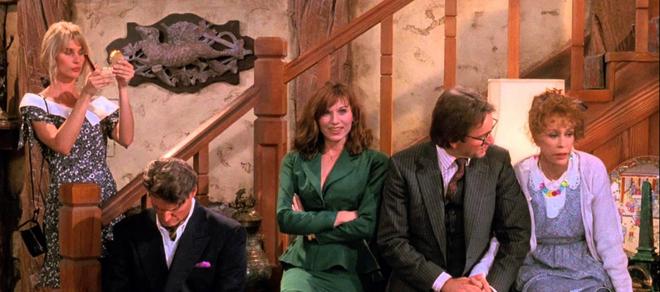


Blocking:Theplannedmovementofactorsonstage givenbyadirector
Breakingthefourthwall:Whenanactorspeaksdirectly totheaudience,steppingoutofthestory.It’slike breakingtheinvisible“wall”betweentheactorsandthe audience
Cue:Asignal(line,movement,orsound)thattellsan actorwhentospeakormove.
Director:Thepersoninchargeoftheshow.Theyguide theactors,designteam,andoverallvisionoftheplay tobringittolifefromthepagetothestage
Dressrehearsal:Afinalrehearsalwithfullcostumes, props,andtechnicalelements.
Dresser:Someonewhoworksbackstage,assisting actorswithquickcostumechangesduringtheshow
Farce:Acomedythatusesexaggeratedcharactersand improbablesituationsforhumor Doorsbecometheir owncharacterinthisstyleoftheater.
Flats(setflats):Lightweightwallsusedtoconstruct stagescenery
Improvisation:Unscriptedactionordialoguemadeup onthespot
Onbook:Astagemanagerorassistantwhofollows alonginthescriptduringrehearsalsandgivesactors theirlinesiftheyforget
Playwright:Thepersonwhowritestheplay.Justlikean authorwritesabook,theplaywrightcreatesthescript fortheactorstoperform.Unlikewithnovels, playwrightshavetokeepinmindcastsize,scene changes,setting,etc.
Promptcorner:Abackstageareawherethestage managerorcrewcancuelights,sounds,andentrances.
Props(Properties):Objectsusedonstagebyactors duringaperformance(eg phones,newspapers,plates)
Proptable:Abackstagetablewhereallthepropsare organizedandlaidoutfortheactorstograbbefore goingonstage.
Stagedirections:Instructionsinthescriptthattell actorswheretomove,howtospeak,orwhatemotion touse
StageManager:Thepersonwhokeeps everythingrunningsmoothly.Theyorganize rehearsals,communicatebetween departments,and“call”theshowduring performances.
Technicalrehearsal:Arehearsalfocusedon lighting,sound,set,andtechnicalelements
Timing:Howwellcues,lines,andactionsare deliveredattherightmomentforthebest effect Averyimportantaspectoffarceand comedy
Turntable:Arotatingsectionofthestagefloor thatcanspinduringaperformancetochange sceneryorcreatedramaticeffects
Understudy:Anactorwholearnsthelinesand blockingforamainroleandisreadytostepin iftheleadactorcan’tperform.
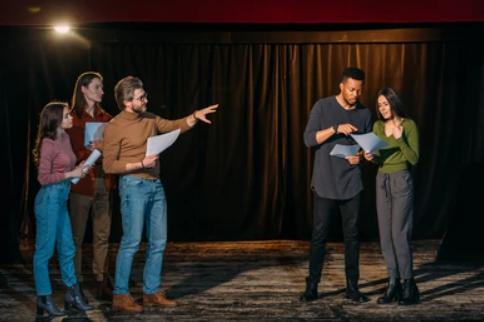
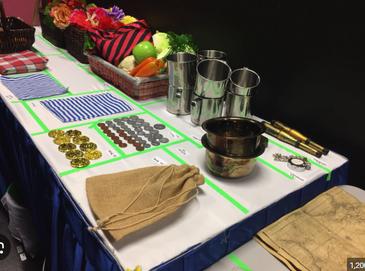
"That's what it's all about. Doors and sardines. Getting on, getting off... That's farce. That's the theatre. That's life." - Lloyd Dallas, Act I
Farce is a type of comedy where the story and situations are exaggerated to the point of being silly or ridiculous It often includes wild physical humor, over-the-top characters, and crazy events. Some critics think farce is not as smart or artistic as other kinds of comedy, but it has stayed popular because people enjoy watching it.
Farce has roots in ancient Greek and Roman theater In plays by writers like Aristophanes and Plautus, actors played familiar character types, like the greedy man, the old fool, or the clown, who ended up in ridiculous situations.
The word "farce" was first used in 15th-century France At the time, actors added funny, silly scenes into serious religious plays. These added parts were called "farce," from the French word meaning "stuffing," like something extra stuffed into the play. These performances included clowning, physical comedy, and sometimes rude jokes Farce soon spread across Europe

In England, writer John Heywood created short farces in the 1500s Later, famous playwrights like Shakespeare and Molière used farcical elements in their comedies.
Farce continued to be popular in the 1800s and 1900s In France, plays like An Italian Straw Hat (1851) by Labiche and A Flea in Her Ear (1907) by Feydeau were big hits Farce also showed up in vaudeville and music hall performances variety shows full of comedy, songs, and skits
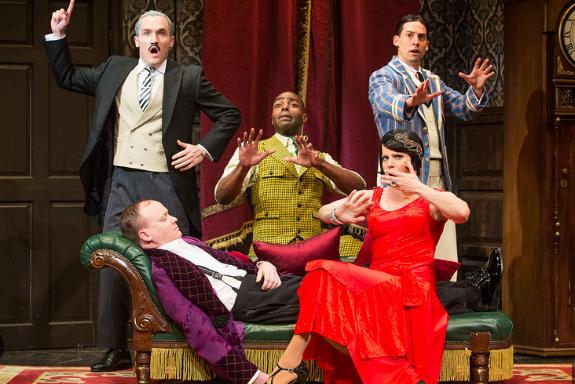
Later, farce appeared in movies, especially silent films. Stars like Charlie Chaplin, the Keystone Kops, and the Marx Brothers made audiences laugh with crazy chases and slapstick humor.
In London, farces at the Aldwych Theatre between World War I and II were very popular. Even today, farce is still alive in TV shows and plays Written in 1982, Michael Frayn’s Noises Off is still one of the most popular modern farces, and is regularly staged across the world.
“All the world’s a stage / And all the men and women merely players” Shakespeare’s As You Like It
A story within a story, also called an embedded narrative, is a literary device where a character in a story becomes a character in a second story that exists within their world. Embedded narratives show up in all kinds of stories; a play may have another play within it, such as in Shakespeare's play Hamlet; a film may show the characters watching a short film; or a novel may contain a short story within the novel Embedded narratives can be used in all types of narration including poems, and songs
Embedded narratives can sometimes appear to be just for fun, or they can be used to teach lessons to other characters The inner story often has a symbolic and psychological significance for the characters in the outer story There are often parallels between the two stories, and the fiction of the inner story is used to reveal the truth in the outer story Often the stories within a story are used as satire to critique the views not only in the outer story, but also in our real world

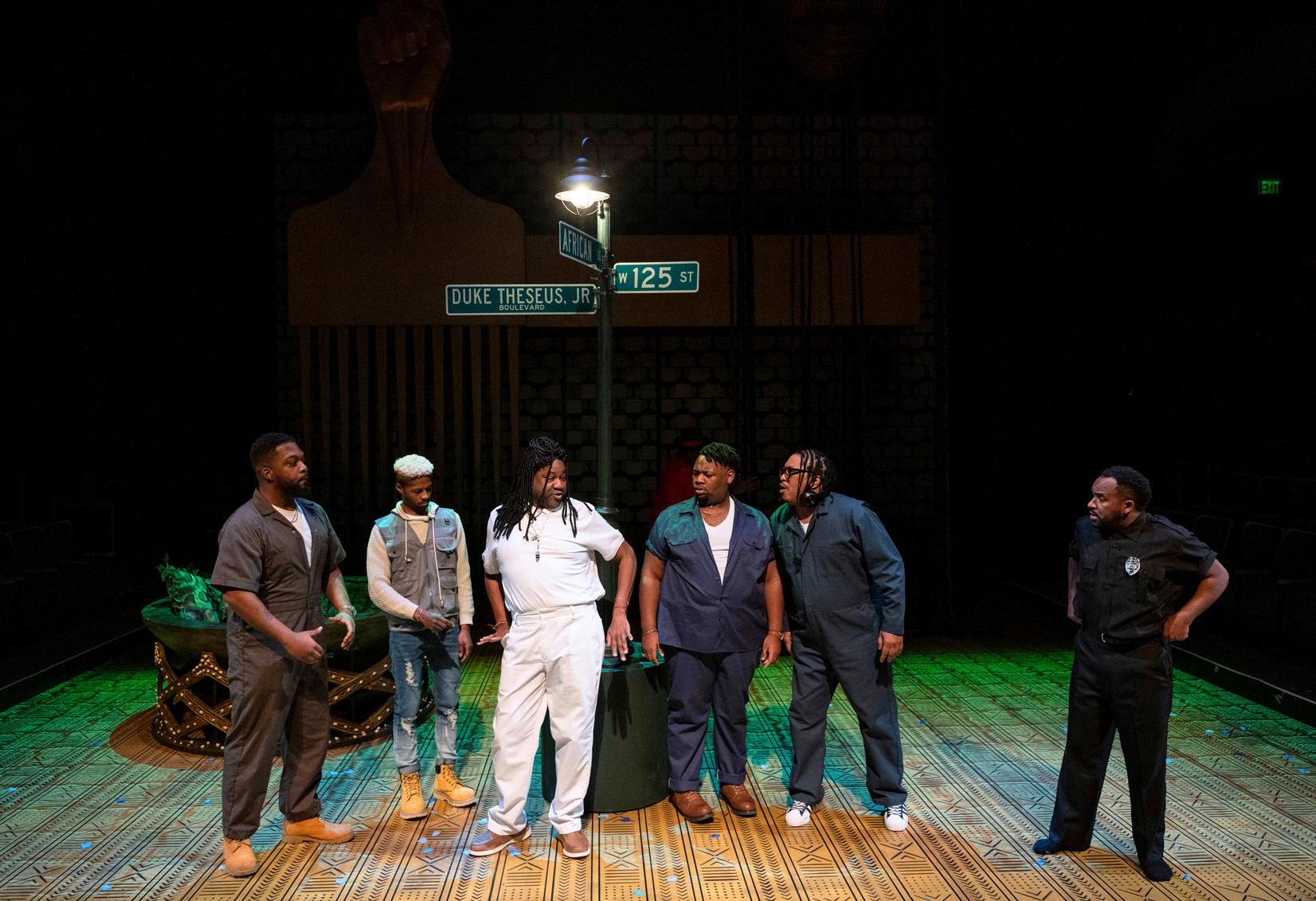
When a story is told inside of another, instead of being told on its own, it gives the author an opportunity to inform the reader's perceptions of the characters and the world. How are the characters in the Embedded Narrative similar or different from the characters in the main story?
Embedded narratives can give you hints about the background of characters or events, foreshadow events in the future of the main plot, or sometimes seem to be irrelevant to the main plot all together In some cases, like in Trouble in Mind, the Embedded Narrative is involved in the action of the plot of the outer story. In other cases, the inner story might seem like it doesn’t matter, but taking it out makes the rest of the story fall flat.
DRAMATIC IRONY
For ages 13+
Marketing plays a key role in any theater production. The marketing team helps design the images and materials used for posters, playbills, websites, and social media. They also make sure this information reaches the public, so people know when and where a show is happening.
Overview

In this activity, students will create a mock social media post to promote Nothing On, the fictional play within Noises Off. This exercise invites students to think creatively about marketing, tone, visual design, and how theatrical productions are presented to the public
Step 1: Introduce the concept
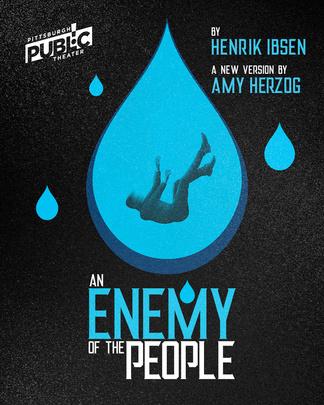
Explain that Nothing On is the fictional play being rehearsed throughout Noises Off. It is intentionally over-the-top, farcical, and full of chaos and misunderstandings
Ask students to imagine they are part of the Nothing On marketing team and need to create a social media image to promote the show.
Step 2: Student Assignment
Each student (or pair/small group) will design a social media graphic for Nothing On
Their design should include:
A title or tagline
Images or illustrations (hand-drawn or digital)
A brief captivating caption
Optional: hashtags, websites, emojis, or cast "quotes"
Step 3: Design Options
Students can design their promo by hand on paper or digitally using platforms like Canva, Google Slides, or Adobe Express. You may wish to provide templates or a few examples of real theater social media posts as inspiration (see above for two social media images used by PPT for this season).
Keep in mind
The tone of the play and how that might effect the design
The central theme of the play and how that might effect what images you use
What kind of audience will come to this play and how that might effect your design choices.
Mrs Clackett, the housekeeper, believes she has the house to herselfuntil multiple unexpected visitors begin arriving. They attempt to sneak around the house without being seen, leading to escalating confusion As more characters enter and try to hide their true intentions, chaos ensues - complete with missing sardines, missing clothes, and plenty of slammed doors

Imagine you are in the cast of NOISES OFF. Write a journal entry about a rehearsal that goes wrong.
Thingstoconsider:
Whatpartoftheshowareyourehearsingthatday?
Whointhecastdoyougetalongwithandwhodoyounothowdoesthatshapeyourjournalentry?
Whatpersonaldramamightbespillingintotherehearsal room?
Isthereamajormishapthatoccurs?
Howdoesthedirectorreacttothechaos?

When you're ready, share with the group. Read your journal entry out loud speaking as if you were that character. How would that character use their tone of voice and body movements to narrate what happened?
Improv Game: Prop Out of
For ages 13+
Objective: To encourage creativity, quick thinking, and confidence through imaginative use of everyday objects.
Inform students that there is a box of random objects at the front of the room. One at a time, students will come up, randomly pull out an object, and have 5 seconds to think about what else the object could be They’ll then act out how someone might use this new object (like charades) for about 30 seconds. Afterwards, the rest of the class will try to guess what the object has become.
Step1:PreparethePropBox
Fillaboxorbagwithavarietyofrandom,safeobjects(eg,spatula,hat, phonecase,sunglasses,ruler,toy,etc.).
Youcaninvitestudentstobringinclean,school-appropriateitems aheadoftime.
Step2:PropSelection
Onestudentatatimecomestothefrontandpullsoneobjectfromthe boxwithoutlooking.
Givethem5secondstodecidehowthey’llusetheobjectinanewway
Reminder:thestudentmustusethepropassomethingcompletely differentthanwhatitactuallyis themoreimaginative,thebetter! Forexample:Ashoebecomesatelephone.Awaterbottle becomesatelescope
Step3:Performance
Studentswillthenactoutashortmomentusingth newrole
Encourageboldchoicesandclearphysicality don’ttellus
Timelimitreccomendation:30–60secondsper tokeeptheenergyup.
Step4:ClassEngagement
Therestoftheclasswatchesandwilltrytoguessw objectisbeingusedas


Reminder:Encouragepositivefeedbackandapplause aftereachturn.
For ages 13+
The questions below are intended to support educators in facilitating thoughtful discussion around the play’s structure, characters, comedic style, and underlying themes. These discussion prompts are designed to help students analyze the play more deeply.
What do you think makes Noises Off funny – the script, the actors, the physicality or a combination?
Do you think this play would work in another medium such as a movie or tv show? Why or why not?
How did the repeated use of doors help tell the story or add to the humor?
What did you notice about the design elements - set, props, lighting, sounds, and costumes? How did they contribute to the show?
What do you think this play says about the behind-the-scenes experience of putting on a show?
Perspective
Each act shows the same scene but from a different perspective.
What new things did you learn in each act?
How does the comedy shift or evolve in each act?
How does the story itself change from act to act? - Anything become more important, or less?
How do the viewpoints or focus of each act differ?
Comedy
What does it mean when we say that comedy is all about timing?
How is timing used effectively in this play and why is it essential to the story?
In what way does Noises Off poke fun at the world of theater?
What was one moment that made the audience laugh, and what made that moment work so well?
Character
How did the actors distinguish between their main characters and the characters in the play Nothing On?
What might be confusing or challenging for an actor cast in Noises Off?
What character stood out to you the most and why?
How did the personal relationships among the cast members affect the way they performed and prepared for Nothing On?
If you were cast in this play, which character would you want to play? And what in particular draws you to that role?
AberystwythFestival:AWelshtownthatholdsmanyart-centeredfestivals
Airingthebed:Thispractice,whichisacommontraditioninmanycountries, involvesstrippingthecoversandexposingthemattressandbeddingtofreshairand sunlightand,allowingthebedto"breathe".
Arabpotentates:powerfulArabrulers,suchasmonarchs,dictators,orleaderswith significantauthority,whopossessimmenseinfluenceandoftenhavelargely unlimitedpower.
ArabSheikh:AwealthyMiddleEasternman(usedasadisguiseintheplay-within-aplay).
Asthon-under-Lyne:AmarkettowninTameside,GreaterManchester,ontheRiver Tame.
Basingstoke:AlargetownandboroughinHampshire,southwestofLondon.
BattleofWaterloo:ThebattletookplaceonJune18,1815nearthevillageof Waterloo,southofBrussels,inpresent-dayBelgium.TheFrenchAmry,under EmperorNapoleon,foughtagainsttheSeventhCoalitionconsistingofBritish,Dutch, Belgian,andGermantroopsledbyWellington,andarapidlyarrivingPrussianarmy underBlücher.ThisbattlemarkedthefinaldefeatofNapoleonBonaparte,endinghis reignasemperor,andconcludedtheNapoleonicWars,establishingaperiodof relativepeaceinEurope.
Bullionvaults:Ahighlysecure,specializedfacilityforstoringpreciousmetalslike gold,silver,andplatinum,offeringprotection,professionalmanagement,and insurancethatsurpassestypicalhomeorbankstorage.
Burglaralarm:Asecuritysystem;importanttotheplotoftheplay-within-a-play.
Burnous:Along,loosehoodedcloakwornbyArabs
Fortnight:Aperiodoftwoweeks
Holdall:ABritishtermforalargesoftbagoftenmadeofcanvasorleatherandused whiletraveling.
Inlandrevenue:Thegovernmentdepartmentthatisresponsibleforadministering andcollectingtaxesonincome,profits,andgains
Innuendo:Adoublemeaning,oftensuggestiveorhumorous
Loo:Britishtermfortoilet
MyraHess:DameMyraHess(1890–1965)wasaBritishclassicalpianistcelebrated forhervirtuosityandsensitiveinterpretationsofclassicalworks.DuringWorldWar II,sheorganizedandperformedindailylunchtimeconcertsatLondon'sNational GallerytomaintaincivilianmoraleduringtheGermanbombardment




Old-AgePensioners(OAPs):IsaBritishtermthatreferstoanelderlypersonwho receivesaregularpayment,apension,fromtheiremployerorthegovernment,often afterretiringfromwork.
Oxfam:Originatingin1942astheOxfordCommitteeforFamineRelief,Oxfamhas grownintoaglobalconfederationoforganizationsfightinginequalitytoendpoverty andinjustice,providinghumanitarianaidandadvocatingforeconomicjustice, women'srights,andclimateactioninmorethan80countries.
Posset(PossetMill):Possetisatraditionalhotspicedmilkdrinkcurdledwithalcohol thatlaterevolvedintoasweetdessert.
Postprandial:Theperiodoccurringafterameal.
Prosecutingforincitement:Provingsomeone’sspeechwasdirectedtoinciteor produceimminentlawlessaction.
RichardIII:KingofEngland,reigningfrom1483to1485.Heisinfamousforthe suspectedmurderofhisnephewsand,throughWilliamShakespeare'splay,becamea symboloftyrannicalkingship,thoughmodernscholarshipsuggestshisreputation mayhavebeenunfairlytarnishedbyhisenemies.
“Squire,Squire,HackhamandDudley”:Thenameofafictionalreal-estatefirm mentionedbythecharacterMrs.Clackettintheplay-within-the-play,NothingOn.
Sardines:Small,oily,nutrient-densefishbelongingtotheherringfamily.Theterm "sardine"isnotspecifictoasinglespeciesandcanrefertoavarietyofsmall,edible fishesfoundthroughouttheworld'soceans.
“StandingtherelikeHamlet’sfather”:AreferencetoShakespeare’splay,Hamlet, whereHamlet’sfatherisaghost.Thisphraseisusedtodescribesomeonewhois presentbutignored,unseen,orunheard.
Tremulously:Todosomethinginatrembling,hesitant,orunsteadymanner.
Tarty:Dressedinawaythatisconsideredvulgarorimmodest.
Tannoy:ABritishtermforaloudspeakerorasoundsystemusedformaking announcementsinpublicplaces.
Weeklyrep:Atermforaspecifictypeofrepertorytheatre,mostnotablypracticedin 20th-centuryGreatBritain.Itinvolvedaresidentcompanyofactorsthatproduceda newplayeveryweekortwo,whichwasthenperformedforashort,continuousrun.
Weston-Mare:AnEnglishseasidetowninSomerset.



English Language Arts: Grades 6-12
CC.1.2.8.G: Evaluate the advantages and disadvantages of using different mediums (e g , print or digital text, video, multimedia) to present a particular topic or idea
CC.1.2.9-10.G: Analyze various accounts of a subject told in different mediums (e.g., a person’s life story in both print and multimedia), determining which details are emphasized in each account.
CC.1.2.11-12.G: Integrate and evaluate multiple sources of information presented in different media or formats (e g , visually, quantitatively) as well as in words in order to address a question or solve a problem
CC.1.3.8.A: Determine a theme or central idea of a text and analyze its development over the course of the text, including its relationship to the characters, setting, and plot; provide an objective summery of the text.
CC.1.3.9-10.A: Determine a theme or central idea of a text and analyze in detail its development over the course of the text, including how it emerges and is shaped and refined by specific details; provide an objective summary of the text
CC.1.3.11-12.A: Determine and analyze the relationship between two or more themes or central ideas of a text including the development and interaction of the themes; provide an objective summary of the text.
CC.1.3.8.C: Analyze how particular lines of dialogue or incidents in a story or drama propel the action, reveal aspects of a character, or provoke a decision
CC.1.3.9-10.C: Analyze how complex characters develop over the course of a text, interact with other characters, and advance the plot or develop the theme.
CC.1.3.11-12.C: Analyze the impact of the author’s choices regarding how to develop and relate elements of a story or drama
CC.1.3.8.G: Analyze the extent to which a filmed or live production of a story or drama stays faithful to or departs from the text or script, evaluating the choices made by directors or actors
CC.1.3.9-10.G: Analyze the representation of a subject or a key scene in two different artistic mediums, including what is emphasized or absent in each treatment
CC.1.3.11-12.G: Analyze multiple interpretations of a story, drama, or poem (e g , recorded or live production of a play or recorded novel or poetry), evaluating how each version interprets the source text
CC.1.4.8.H: Introduce and state an opinion on a topic.
CC.1.4.8-12.M: Write narratives to develop real or imagined experiences or events
GRADE 8
TH:Cr1.1.8
a Imagine and explore multiple perspectives and solutions to staging problems in a drama/ theater work
b Imagine and explore solutions to design challenges of a performance space in a drama/theater work
c. Develop a scripted or improvised character by articulating the character’s inner thoughts, objectives, and motivations in a drama/theater work.
TH:Re7.1.8
a Apply criteria to the evaluation of artistic choices in a drama/theater work
TH:Re8.1.8
a Recognize and share artistic choices when participating in or observing a drama/theater work.
b. Analyze how cultural perspectives influence the evaluation of a drama/theater work.
c. Apply personal aesthetics, preferences, and beliefs to evaluate a drama/theater work
TH:Re9.1.8
a Respond to a drama/theater work using supporting evidence, personal aesthetics, and artistic criteria
b Apply the production elements used in a drama/theater work to assess aesthetic choices.
c. Assess the impact of a drama/theater work on a specific audience.
Grade Hs proficient
TH:Cr1.1.HSI
a Apply basic research to construct ideas about the visual composition of a drama/theater work
b Explore the impact of technology on design choices in a drama/theater work
c. Use script analysis to generate ideas about a character that is believable and authentic in a drama/theater work.
TH:Re7.1.HSI
a Respond to what is seen, felt, and heard in a drama/theater work to develop criteria for artistic choices
TH:Re8.1.HSI
a. Analyze and compare artistic choices developed from personal experiences in multiple drama/theater works.
b. Identify and compare cultural perspectives and contexts that may influence the evaluation of a drama/theater work
c Justify personal aesthetics, preferences, and beliefs through participation in and observation of a drama/theater work
TH:Re9.1.HSI
a. Examine a drama/ theater work using supporting evidence and criteria, while considering art forms, history, culture, and other disciplines.
b. Consider the aesthetics of the production elements in a drama/theater work
c Formulate a deeper understanding and appreciation of a drama/theater work by considering its specific purpose or intended audience